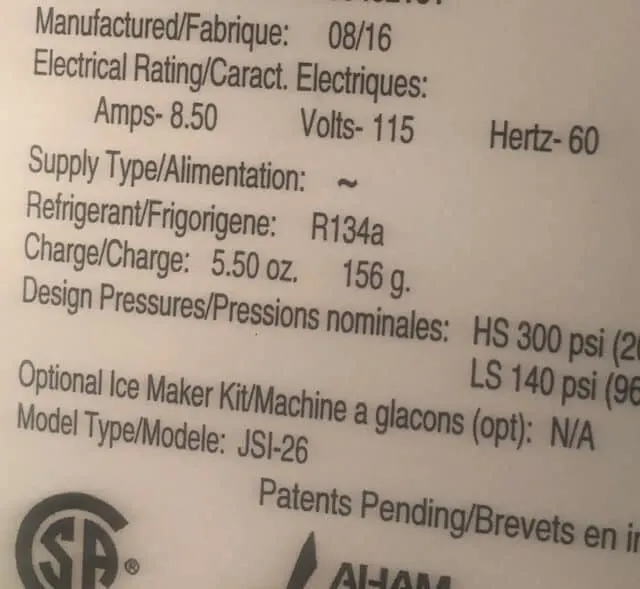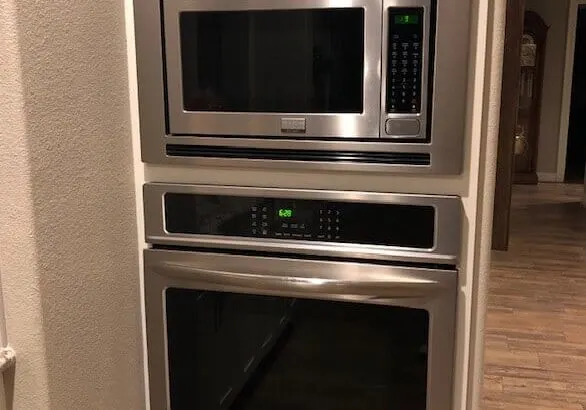I’ve seen the marketing hype over Energy Star appliances and the money they can save you. I spent a long time researching whether or not it made sense for me to upgrade my appliances to save money on energy. This is what I learned.
There are seven critical factors to determining if an appliance is worth upgrading:
- Age of current system
- The anticipated remaining lifecycle of the current system
- Energy use of the current system
- Energy use of proposed system upgrade
- Projected annual savings yield for the upgrade
- Timeline for return-on-investment
- Anticipated years of use
It’s not enough to simply say an appliance upgrade will save you money. That’s what salespeople tell you but there is a formula to determining if an appliance upgrade really makes sense for you.
Appliance Salespersons Are Not Energy Efficiency Experts!
First, a word of warning. The people who get paid to sell you appliances are not energy efficiency experts. Their goal is not to ensure that you make a well-researched and logical buying decision. They get paid to sell appliances. Period.
The more money that you spend on a washing machine, the more money the company makes. It is in their best interest to sell you a higher priced appliance.
You may be surprised to learn that when I built my new home in 2016, I did not opt for the Energy Star rated appliances. That’s right, the energy efficiency fanatic did not pay the Energy Star premium. Why?
I knew that my family would only live in this house for a few years. As you’ll learn from the formula that I’m going to share with you, there is a timeframe required to recoup the initial additional costs associated with higher efficiency appliances. In my situation, the math didn’t add up.
Let’s learn how to do our due diligence and truly determine if an appliance upgrade is the right decision for your situation.
Age of Current System
Often you will find a date of manufacturing on the manufacturer’s label. For example, on my refrigerator’s manufacturer’s label, it clear shows that he product was manufactured in 2016 (we do not need the month for our calculations, only the year).

If the manufacture’s label does not indicate the age, you can often find that information (or an estimate) on the internet.
For example, I was working on a rental house where the outside central air unit’s label was decayed from the weather. I couldn’t read the whole thing but I was able to get the model number off of it. With a little research, I learned the year range that the unit was manufactured.
The Anticipated Remaining Lifecycle Of The Current System
Now that you gathered the current age of each of your systems and appliances, go to this page and obtain the estimated total lifespan of each. Consumer Reports has done the hard work for us on this and we can use their research to speed this process along.
The figure we are actually looking for comes from subtracting the current age from the estimated total lifespan. For example:
Central Air System
Current Age – 10 years
Estimated Total Lifespan – 15
Anticipated Remaining Lifecycle of Current System = 5 years (Total Life minus current age)
Are you starting to see what we are doing with these?
Energy Use Of The Current System
Another key piece of information that you’ll need is the energy use of the current system. The manufacturer’s label should state this, however, you can also obtain it from the internet if needed.
You can really geek out on how to calculate energy usage. For a detailed overview of calculating energy use and cost based on watt hours, see this video:
For our purposes, we just want to make sure we are
Note: Even if you are not considering a replacement at this time, go ahead and go through this process of collecting current energy use for each system so that you will have it when the time comes for replacement.
The Department of Energy reports that around 15% of a U.S. household’s energy consumption is the result of appliances. That’s not a small number. We need to determine exactly what that amount looks like for you and see if there is a potential energy savings opportunity that makes sense. This process is worth your time!
Energy Use Of Proposed System Upgrade
What I recommend you do here is select at least potential upgrade models. You want to select one based on energy use and one based on price. For example, if I were looking at replacing my refrigerator I would want to have comparison replacement models of an Energy Star rated refrigerator and an inexpensive model.
Why? Because depending on your anticipated years of use and potential energy savings over time (both of which we will dig in to later), the most energy efficient model may not be the best investment. I know, this flies in the face of marketing logic. But we want to make an informed decision here, not just follow the trends blindly.
So, select two potential upgrades. One based on efficiency (focus on Energy Star Rated options), and one based on price. Take note of the energy use of these replacement options, again, ensuring that you are using the same energy measurement as the current system (amps, watts, etc.).
Projected annual savings yield for the upgrade
So here we are again, tasked with some basic math. Not to worry, this is basically the same process as before. We are simply going to subtract the energy usage of the propsed replacement from the energy use of the current system.
If the current system uses 6.8 amps, and the proposed uses 4.6 amps, then the projected savings is 2.2 amps. It’s as simple as that.
Actually, it’s not. There are a ton of ways that you can aggregate this data to come up with more precise measurements based on average usage, etc. but for our purposes, this gives us the information that we need. Keep it simple and keep pushing forward!

Timeline For Return-On-Investment
What we are looking for here is how long a purchase will take to pay for itself in energy savings. It’s simple math, at least the way we are going to do it.
Using the example above, we stand to save 2.2 amps in energy usage if we upgrade to our proposed replacement appliance. If we consider an annual savings of 2.2 amps, we will hit budget neutral in just a few years.
Each year after that we begin recouping our costs until the investment has paid for itself and we are seeing a positive return on our investment.
Here’s the formula in our example:
Current System – 6.8 amps
Proposed System – 4.6 amps
Projected Savings -2.2 amps (current minus proposed)
All of this is fine and dandy but it is hard to calculate savings based on Amp hours. There are two steps we need to take here. This first is to use the amp hours and volts and determine our
This online amp hour to watt hour calculator will do the work for you.
That helps, some but what we really need to do is convert these
You can do this easily using this energy cost calculator. Enter the information and it will give you the actual cost of running that appliance. You will need your kWh cost from a recent utility bill but the magic of the math formulas is done for you.
So, let’s look at this again from a dollar savings standpoint.
Annual cost to run current appliance – $300
Annual cost to run proposed replacement appliance – $200
Projected annual savings – $100
So, we are saving $100 per year. Pretty sweet, right? But hold on, we still have the cost of that new system to deal with.
Timeline to budget neutral – This represents how long it will take for the $100 annual savings to offset the price we paid for the energy efficient replacement appliance.
Let’s assume that we paid $1000 for the new, energy efficient appliance. It’s Energy Star rated and we went all out. From this scenario, it’s pretty easy to see that it will take ten years just to hit budget neutral ($1000 divided by $100 per year equals 10 years).
Got it? Great! We are almost done!
Anticipated years of use
The final consideration and this is a big one, is how long we anticipate using that new, energy efficient appliance. If you are likely to move within the next 5 years or so, it may not make sense to spend more on an Energy-Star rated high-efficiency appliance.
You may be better off waiting to replace your current system until you have to and then replacing it with an inexpensive, less efficient model. If you even end up having to replace it at all before you move.
If, on the other hand, you foresee 15-20 years ahead of you using the new appliance, an Energy Star upgrade may make sense. But this is where the average lifespan of appliances comes back into play.
If an upgrade will require 10 years just to
Sure, it may last longer than that but the efficiency of appliances degrade over time so the annual savings will likely not be as much as it ages.
Let’s look at the refrigerator upgrade example one more time and apply this.
We have already established that with an annual savings of $100 per year, our new energy efficient refrigerator will pay for itself in energy savings in ten years. Guess what the average expected lifespan for a refrigerator is?
13 years!
That means that we will get about 3 years of total profit in energy savings before the system is ready for a replacement. We will see about $300 in actual dollars in our pocket from energy savings over the next 13 years.
Is that a compelling reason to upgrade? That’s a decision you’ll have to make for yourself. The point is, the payoff doesn’t really start until the product has paid for itself in energy savings, and that can take years.
And that’s the part that no appliance salesperson will ever bother to explain to you.

Conclusion
Believe it or not, I a big fan of Energy Star products. If I were building a new house right now that I planned to live in the rest of my life and was weighing the cost of investing more for Energy Star appliances, there would be no debate whatsoever.
On the other hand, if my wife and I decided today that we would live in our current home for the rest of our lives, it would not make sense to upgrade our current appliances since they are only a few years old.
Five years from now the math may work out but as of today, the seven factors that I’ve outlined here make it clear that I am better off sticking with the appliances I currently have.
The truth is, high-efficiency options don’t always make sense for every person in every situation. You have to work through these seven steps to determine if the extra investment is right for you.
Being a bit of an energy efficiency fanatic, that’s hard for me to say. I want the energy savings. But if the math doesn’t add up to me saving more in the long run than I’m going to be spending up front, then it just doesn’t make sense.
The ultimate goal, after all, is not just to have an energy efficient home. The goal is the money you save when it’s all said and done.
This article is an important component to my comprehensive guide on conducting your own home energy audit. I provide a free, downloadable and printable energy audit checklist that you can use to document the current energy efficiency of your home and identify easily addressable energy savings.
Be sure to read the guide before you leave. If you don’t, you are leaving hundreds, possibly even thousands of dollars in energy savings on the table!
As a homeowner, I am constantly experimenting with making the structure of my house more energy-efficient, eliminating pests, and taking on DIY home improvement projects. Over the past two decades, my family has rehabbed houses and contracted new home builds and I’ve learned a lot along the way. I share my hard-learned lessons so that you can save time and money by not repeating my mistakes.

